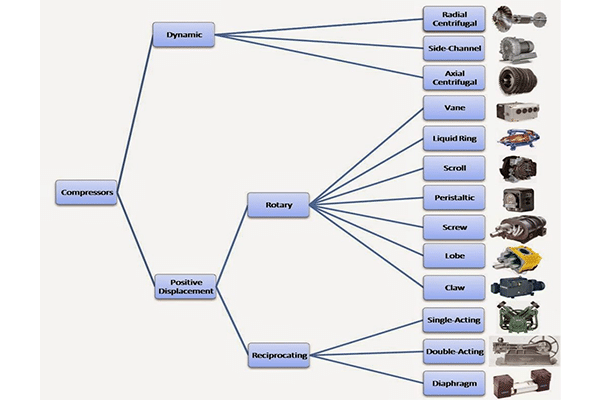Air Compressor Works
Post
Compressor Basics: Types of Compressors
August 25, 2017

This post we will be going over the different types of air compressors. As we discussed last post, an air compressor takes ambient air and decreases its volume. This causes the pressure and temperature to rise. Decreasing the volume is the “compressing” that air compressors do. I should qualify that this is how positive displacement compressors increase the pressure. There are dynamic compressors that use a different method.
The two main types of compressors are dynamic and positive displacement.
The positive displacement compressor is probably the one you’re familiar with. It traps gas in a volume and then decreases that volume. The decrease in volume causes a rise in pressure. In layman’s terms we’re squeezing the air.
A dynamic compressor uses a rotating element (usually called an impeller) which increases the velocity of a gas stream, and that is converted to pressure by then slowing it through a diffuser. I guess in layman’s terms you’d look at this as a traffic jam on the interstate and the cars are the air particles. Everybody is moving fast and has good spacing (well…not everybody), when a wreck blocks traffic in one lane. The cars then slow down and get closer together. When the same amount of air molecules that were spaced out are now jammed closer together – that’s pressure.
From there it breaks down into different technologies.
The positive displacement compressors break down into two main categories: Rotary and Reciprocating.
Rotary compressors use one or more rotating elements in a housing (called an air end) to decrease the volume and increase the pressure.
Reciprocating compressors use a piston in chamber called a cylinder to decrease the volume and increase the pressure. They are commonly referred to as “piston compressors.”
Each technology has it’s advantages and disadvantages. What technology you choose should be chosen based on:
- What pressure do you need?
- What flow do you need?
- What are the ambient conditions? (temperature, humidity, altitude, hazardous location, ect.)
- What is the level of purity you need and what dew point is required?
- What is the media you are compressing? (air, nitrogen, natural gas, helium, refrigerant, ect.)
- Are there sound or vibration limits that you have to meet?
Every situation is different so there may be other factors, as well.
This blog will go over some technologies briefly and some in depth. Next post we’ll look in depth at reciprocating compressors with a focus on the single-acting ones.
Contact Us
Contact Us
Palm beach:
1956 W 9th St
Riviera Beach, FL 33404
Monday – Friday 7:30 AM - 4:30 PM
Map and Directions
Miami:
7292 NW 25th St
Doral, FL 33122
Monday – Friday 7:30 AM - 4:30 PM
Map and Directions
Phone Number:
Areas We Serve
- Miami
- Fort Lauderdale
- Hollywood
- Boca Raton
- Stuart
- Vero Beach
- Delray Beach
- West Palm Beach
- Homestead
- Key West
- Fort Pierce





